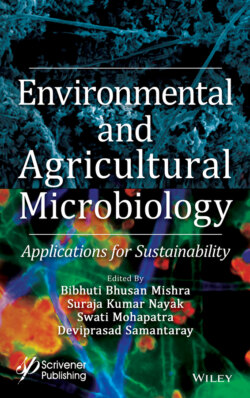Читать книгу Environmental and Agricultural Microbiology - Группа авторов - Страница 42
2.4 Mechanism Involved in Hexavalent Chromium Reduction in Microalgae
ОглавлениеPolysaccharide is the basic building block present in the cell walls of prokaryotic and eukaryotic microalgae following proteins and lipids [57]. They contain functional groups like phosphate, amino, sulfhydryl, thiol, and carboxylic groups which are mostly capable of binding to the heavy metals as per their specificity and affinity as seen in Figure 2.2.
Cyanobacteria are able to synthesize metallothioneins (intracellular metal binding proteins) [58]. These are low molecular weight proteins (6,000 to 8,000 amu) rich in cystein residue and bind to metal ion in metal thiolate cluster. It has been reported that cyanobacterial species like Oscillatoria sp., Gleocapsa sp., and Spirulina sp. have the ability of synthesizing siderophores possessing metal chelating properties [50]. It has also been noticed that the heavy metals get deposited in polyphosphate bodies (intracellular storage compartments). Besides this they have also some other advantages like larger surface area, high binding affinity, simple nutrient requirement, and greater mucilage volume which help them to act as biosorbents [55]. Besides this, another mechanism involves the partitioning of metal ion between cell wall and exopolymer sheath [58].
Figure 2.2 Schematic diagram: Mechanism of Cr(VI) reduction through micro-algal biomass.
Except extracellular chromium reduction, intracellular reduction can also be taken as a major mechanism. Algal cells are found to be better source of Cr(VI) reduction, so there must be presence of Cr(VI) reducing enzymes in their cells like bacteria and fungi. The protoplasm of these cells contains some components such as NADH, proteins, low molecular weight carbohydrates, fatty acids, amino acids, and flavoproteins which can completely reduce Cr(VI) to Cr(III). Generally, in chromium-rich region an oxidative stress condition is created inside the cell leading to the generation of several harmful reactive oxygen species (ROS). In order to avoid this situation, the cell starts to produce special kind of protein, enzyme, or any substance which can able to reduce, remove, or transform the Cr(VI). Besides this, microalgae also release electron through photosynthesis and they have a very unique metabolic process compensating the electron for the reduction of Cr(VI) [16, 59].
According to the findings of Nacorda et al., (2010), there is an initial rapid phase of passive extracellular biosorption process [60]. It was carried out following a slower active intracellular bio-absorption. This method is quite similar to the biphasic uptake take place in bacteria, fungi and other microbes. It is also reported that the longer is the incubation time the higher is the amount of Cr(VI) absorbed by Chlorella vulgaris. Another reason behind this bio-absorption may be due to the high storing capacity of the protoplasm.
